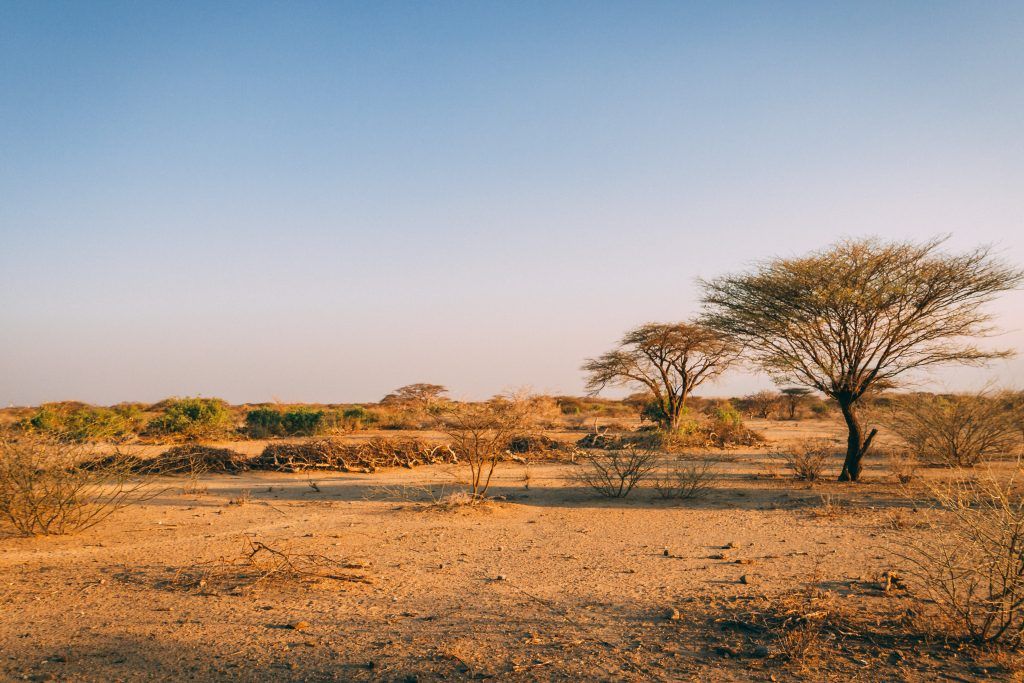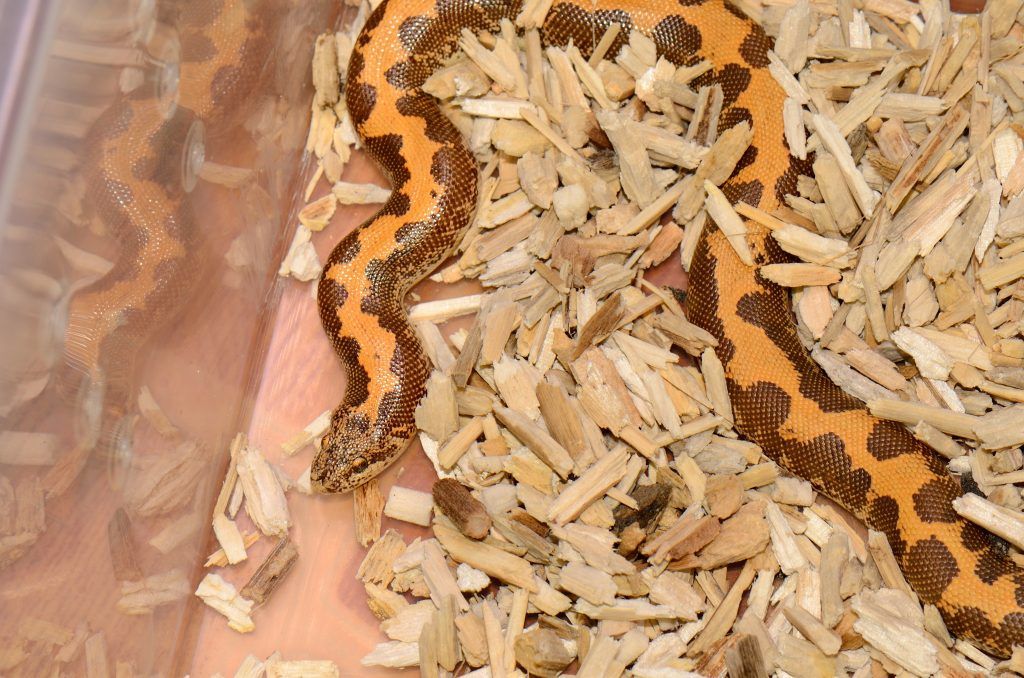The Kenyan sand boa is a snake species that originated in Eastern Africa. They can be found in select countries such as Egypt, Tanzania, Chad, Niger, Yemen, and of course, Kenya. They are a heavily adapted snake species that thrive in semi-arid environments. As their name suggests, they are especially used to living with soil and substrate that is loose and movable, like sand. As pets, Kenyan sand boas are extremely popular, readily available, and easy to take care of!
Species Overview
Basic Appearance
Kenyan sand boas are extremely gorgeous snakes. Their dorsal coloration of orange and brown almost looks like it was painted on them. They have a unique build, with a stalkier body and blunt nose, perfect for digging in the sand. When fully grown, they average around 15-30 inches in length. As a species, females tend to be longer and more bulky than males.
Color Morphs
Even without looking into morphs, Kenyan sand boas are extremely gorgeous snakes. They typically have dorsal coloration, a mottled mix of orange with large contrasting brown spots. Many people admire “wild-type” sand boas, as their coloration is already a sight to behold!
That said, there are many different morphs out there, each with its unique and distinctive appearance. For example, albino morphs are a common but popular option. Another common variety is anerythristic, which lacks red and yellow pigments, making it black and white.
There are also many designer sand boas with distinctive patterns and gorgeous colors, such as:
- Snow
- Stripe
- Paradox
- GX (Gene X)
As well as combinations of these morphs like the calico anery stripe het paradox albino Kenyan sand boa currently for sale on morphmarket.com for a staggering $5,000
Geographic Range

Despite their name, Kenyan sand boas actually live in a range through much of Eastern Africa. Specifically, they range from Egypt to the Northern tip of Tanzania. They mainly choose to live in regions that have loose soils or sands. Within those environments, they can hide in the sand during the day, conserving energy and staying protected.
The Kenyan Sand Boa as a Pet
While sand boas are not quite as popular as ball pythons, they are certainly paving their own home within the reptile community. Their unique coloration and docile demeanor have made them soar in popularity over recent years. You will likely be able to find a Kenyan sand boa at almost any reptile convention, and they have been spotted more and more in typical pet stores.
As pets, Kenyan sand boas are extremely docile. They rarely bite people, and most accidental bites occur due to feeding confusion. Individual sand boas may have differing levels of fear or shyness, but most tend to be receptive to handling and human interaction.
Kenyan Sand Boa Care Guide
Care Sheet
| Family | Boidae |
| Genus | Eryx |
| Life Span | 15-30 Years |
| Mature Size | 15-30 Inches |
| Diet | Small lizards, rodents, and birds |
| Enclosure Size | Male — 30″L x 12″H x “12”W (20 gallon) Female — 36″L x 18″H x 18″W (40 gallon breeder) |
| Temperature | 76 – 85F cold side with a 95F basking area |
| Heating | Under-tank heating |
| Water | Shallow water dish |
| Handling | Whenever receptive |
Kenyan Sand Boa Enclosure Requirements
Kenyan sand boas require a decently large enclosure. As with most reptiles, larger is typically better, especially for females, as they get bigger than their male counterparts.
Although they burrow, sand boa enclosures need a secure lid to prevent escape attempts. An enclosure that is at least 36X18X18 is ideal, with larger sizes being beneficial also. Because they are a terrestrial species, Kenyan sand boa enclosures should be wider than they are tall.
Undertank heaters are the best choice for two reasons. Heat lamps don’t always heat deep enough in the tank or substrate to meet the needs of a burrowing species, and under-tank heaters are often more reliable and controllable, which can prevent burns and overheating complications.
Even though they have sand in their name, you don’t necessarily need to use sand as a substrate. In fact, some reptile keepers dislike how sand has the ability to absorb moisture and clump, or worse, mold! Thus, many people use alternative substrates such as newspaper or a premade reptile mix. The best choice, according to many snake keepers, is aspen shavings because it’s easy to clean, aesthetically pleasing, less dusty than other choices, and can be burrowed in.
Most snakes don’t need UVB light to survive, but evidence shows that providing a little bit can greatly improve their immune response. It’s also easy to overdo it, so if you use one, opt for a small UVB light bulb.
Hides and other decorative elements are great for providing enrichment, but don’t be surprised if your Kenyan sand boa spends most of it’s time burrowed in the substrate.
Feeding and Care

Kenyan sand boas are usually very receptive to feeding. When they are young, they will readily take pinkie mice. As they grow, most people upgrade them to small adult mice. Adult boas should be fed an adult mice around every week or two. When you are initially feeding your boa, it is best to monitor their feeding habits to find out what is best for them.
Most people recommend feeding boas food that is as wide as the widest part of their body. This ensures that they won’t have any issues with ingesting prey. As they grow, it is also recommended to transition them to eating frozen/thawed mice, as this can be safer during feedings.
Unlike a red-tail boa, which needs a water bowl big enough to soak in, you don’t want that for a Kenyan sand boa. They have a tendency to drink too much water and then quit eating because they are “full.” Instead, a shallow water dish is the best option so they can drink fresh water without going overboard.
Reproduction
In the wild, Kenyan sand boas mate around May through July. They usually measure this through temperature cycles that key them into when they should breed. Most reptile keepers who breed sand boas lower their heating to the 70-75F range for a month or two before the breeding season begins. This can help mimic their natural environment and promote breeding.
After a female boa has mated, they will seek out a heat source to help her develop babies. Be sure to include some conspicuous sources of heat that she can find. One amazing thing about sand boas is that they give live birth, which means you don’t have to deal with the hassle of egg incubation!
After the babies have their first shed, you can begin to separate them and feed them fingerling mice.
Common Kenyan Sand Boa Health Problems
While they are an easy species to take care of, Kenyan sand boas do come with their fair share of common health problems. Let’s take a look at some problems that many boas face.
Dehydration and Shedding
One issue that many snakes face is dehydration. This holds true for sand boas as well. In their natural environment, sand boas tend to burrow when they are dehydrated in an attempt to soak up below-ground water. Unfortunately, this strategy does not work well within a man-made enclosure.
This can lead to dehydration, which impacts major processes such as shedding. If you see that your snake is having trouble shedding or is shedding in multiple uneven pieces, it may be time to address its water needs.
To help with dehydration, many people mist enclosures, place out water bowls and create hides that are specifically humid for their snakes.
Mites
Mites are a common issue that affects lots of animals in the pet trade. With snakes, mites generally make their way into the enclosure of feeder mice. Within the enclosure, they can live on the substrate and attack the skin of your snake.
If you suspect that your snake is dealing with mites, you should give its tank a thorough cleaning and purchase some mite-killing products at your local pet store.
Respiratory Illness
Going along with the idea of humidity, too much can also be a bad thing. If your snake is constantly in an extremely humid enclosure, it can cause them to get respiratory illnesses and infections. Some common signs of a respiratory illness include:
- A snake holding their mouth open
- Crackling sounds when a snake is breathing
- Excess mucous production around the nose, mouth, and eyes
If your snake is dealing with respiratory problems, it is recommended to seek health from a professional veterinarian immediately.























